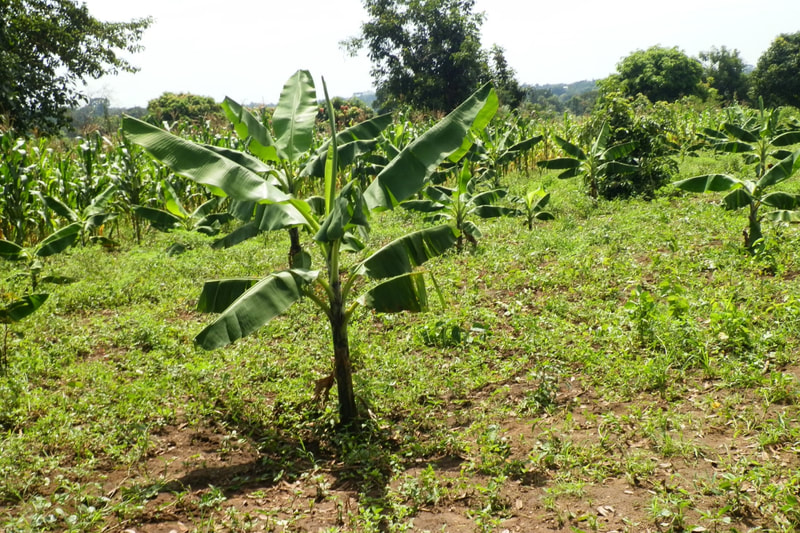Buyanga Primary School, Uganda
The Buyanga Primary School is located in central Uganda. Over 1000 children students attend. Many students are unable to afford books and pens and uniforms, many students walk up to 2 miles each way to and from school and must help their family with their own subsistence farms, tending the animals, gathering firewood, and looking after the younger children. There are many challenges getting through school but providing lunch for these kids is one incentive for parents to send their children to school. We have given out over 150 goats to students in need and served over 250,000 lunches.
Scholarships
Pictured Above: Students at Buyanga Primary School and one of the school buildings
Students who attend Buyanga Primary predominantly learn in Luganda and English. While school is free, students are expected to pay for uniforms, books, pens, and, in seventh grade, an exam known as the P7. Some students pay additional fees to board as their living situation is very difficult. We help provide scholarships for these students.
Students who attend Buyanga Primary predominantly learn in Luganda and English. While school is free, students are expected to pay for uniforms, books, pens, and, in seventh grade, an exam known as the P7. Some students pay additional fees to board as their living situation is very difficult. We help provide scholarships for these students.
Pictured Above: Students inside their classrooms and the faculty of Buyanga Primary
Community Life in Buyanga Village
A rural community, Buyanga Village is 3.7 miles away from the nearest town, Iganga. Without buses, most families cannot afford to take bicycles or taxis, known as boda bodas, to get to Iganga. Highlands east of Buyanga are home to prominent mountain ranges and peaks while Iganga is flat and located in the lowlands.
Community Life in Buyanga Village
A rural community, Buyanga Village is 3.7 miles away from the nearest town, Iganga. Without buses, most families cannot afford to take bicycles or taxis, known as boda bodas, to get to Iganga. Highlands east of Buyanga are home to prominent mountain ranges and peaks while Iganga is flat and located in the lowlands.

Pictured to the Left: Typical Home of Buyanga students
Students usually live with their families in a home like like the one pictured here. Often, kitchens are located outside and shared in large family compounds.
Pictured to the Left: Typical Home of Buyanga students
Students usually live with their families in a home like like the one pictured here. Often, kitchens are located outside and shared in large family compounds.
Most families are subsistence farmers, relying on staple crops such as corn, rice, and matoke (a type of banana). Subsistence farmers have a low income for many reasons. With a large family size average, subsistence farmers often barely grow enough for their large family. Most of these farmers do not have storage facilities, so when they harvest products, they must eat or sell everything. As a result, there is little food or income during the planting season, resulting in food scarcity and malnutrition amongst children.
Our Impact
GVC has partnered with Buyanga Primary School for over five years. Since then, we've initiated a school lunch program, an 13 acre school farm, a goat farm, and Give a Goat Projects to help the community increase school enrollment, education, and work opportunity.
GVC has partnered with Buyanga Primary School for over five years. Since then, we've initiated a school lunch program, an 13 acre school farm, a goat farm, and Give a Goat Projects to help the community increase school enrollment, education, and work opportunity.
School Lunch and Sustainable Organic Farming Projects
GVC began building the farm for Buyanga Primary in 2016 in order to increase enrollment and better nutrition for students. At the time, about 450 students (ages 6-16) attended, many of which came to school hungry and malnourished. We began the farm with 1 acre of 550 Banana tree saplings.
The farm has grown to 13 acres with corn, beans, sweet potatoes, banana and a variety of vegetables. Our farming model includes teaching the kids best farming practices.
Pictured Above: Students eating lunches and crops in the Buyanga Farm
Leaders and families now understand the importance of education.
|
Results
|
When we began the farm in 2016, the school had about 450 students (ages 6-16), many of which came to school hungry and malnourished. For subsistence farmers in Uganda, tuition fees are a serious investment that parents or guardians often struggle to provide. When parents learn that their school fees cover tuition and daily lunches, their decision to send their child to school is easier, and everyone in the family benefits. Once the school started to serve lunch, the number of students grew to over 1,000. Feeding students incentivizes parents to send their children to school, rather than sending them to work in the fields. |
|
Give a Goat Program
GVC has also initiated the Give a Goat Program, which provides provides a source of income for kids who have lost their parents or who are in very difficult living situations. Each $155 donated purchases a fertile milk goat for a child or family in need. Give a Goat is a youth-led nonprofit initiative making social investments in Uganda’s youth. Our goal is to give disadvantaged kids the opportunity to afford both education and nutrition through the gift of a goat. Over 150 goats have been donated to families of the Buyanga Primary School. |
Students and families in the Buyanga community are struggling for survival during this global pandemic. In the last two months, we have been able to feed over 4,000 using donations from the Emergency Food Relief Fund. Some of the people most in need do not have cell phones and were thrilled and surprised to see us arrive at their homes with food and soap. Heart warmed, families cried tears of joy and relief.










